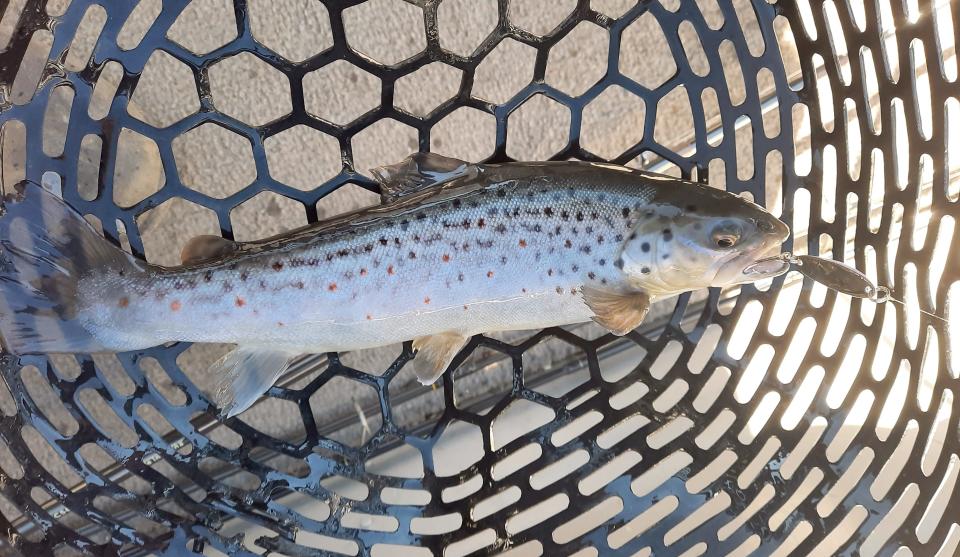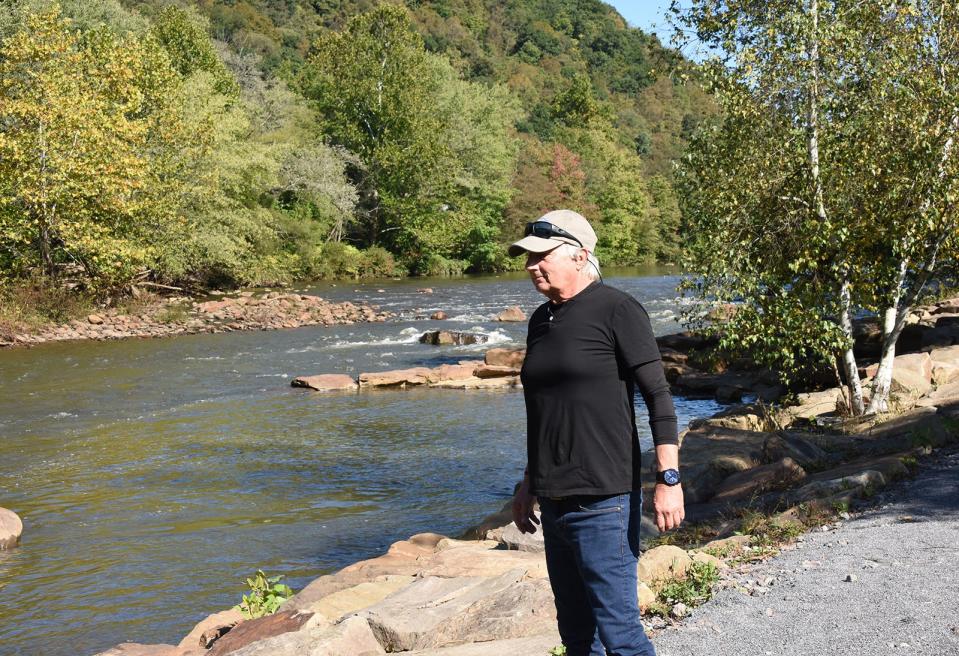How safe is it to eat fish caught in Pennsylvania waters?
Fish caught in many Pennsylvania waterways shouldn't be eaten more than once week, others no more than twice a month, depending on the species. In fact, in some locations, certain fish shouldn't be eaten at all.
That guidance comes from an annual advisory issued by three Pennsylvania agencies: the Department of Environmental Protection, Department of Health and Fish and Boat Commission.
“Generally, fish are safe to eat in Pennsylvania, with the exception of those advisories that we provide to anglers,” said Josh Lookenbill, program manager for the Water Quality Division of the Pennsylvania Department of Environmental Resources.
Anglers planning to go out for the upcoming trout season in Pennsylvania - opening day is April 1 - will receive the 2023 Pennsylvania Fishing Summary Book with their fishing license. Four pages of that book detail how often to eat fish caught in public waterways.

One of the most common pollutants affecting waterways is PCBs, or polychlorinated biphenyls, banned in the United States in 1979 but once widely used by a variety of industries as a lubricant and insulator. According to the U.S. Environmental Protection Agency: "Studies in humans support evidence for potential carcinogenic and non-carcinogenic effects of PCBs."
“Everything from the rail industry to a variety of other industrial processes used PCBs in a fairly ubiquitous manner. And then, based on the processes they were used in, they were also incorporated in the waste stream and discharged either directly into surface waters or to the soil, buried in unlined landfills," Lookenbill said.
It’s a problem that’s not going away anytime soon.
“Generally, we’re seeing the concentrations decrease. There are still high concentrations in some areas, and those higher concentrations will likely persist for decades," he said.
'Pennsylvania advisories are conservative'
Pete Alex III fishes for walleyes and trout, including steelhead and lake trout, in Lake Erie.
He is the president of the Erie PA Sport Fishing Association and charter boat captain for Vision Quest Sport Fishing Charters in Erie and said he has been monitoring the health of fish for more than three decades.
“We think the fish are very healthy, and we think the lake and ecosystems are always improving for the most part. Granted, PCBs and mercury can stay in the lake systems for a long time,” Alex said. "I think our Pennsylvania advisories are conservative.”
Over the decades, the water quality has improved, he said, but “unfortunately with PCBs and mercury, we are paying for our sins of the past."
Lenny Lichvar suggests that to have health issues from eating fish, a significant amount of the protein would need to be consumed.
He's the president of Pennsylvania Trout Unlimited.
“To have real health impairments from eating fish, you have to eat a significant amount of them,” he said.
"All the preservatives and everything else they put in the food you buy at the grocery store might be more of a detriment to you than a handful of fish you eat in Pennsylvania, unless there’s an advisory out by the state that you don’t eat fish in a certain area,” Lichvar said.
Which fish should be limited?
With trout season just a couple of weeks away, the state's Fish and Boat Commission stocks the freshwater fish for the season.
Those stocked trout are subject to a one-meal-per-week consumption advisory that applies to recreationally caught sport fish across the state.
In many waterways, it is recommended to only eat one or two meals a month of fish, like trout or bass, because the fish may have elevated levels of PCBs or mercury.
Other places, like in the Lake Erie Basin, it is advised by the state not to eat carp more than 20 inches long or lake trout more than 30 inches long.
Fish caught in Neshaminy Creek in southeastern Pennsylvania, which includes Montgomery and Bucks counties, should not be eaten. The region tested positive for PFOS (perfluorooctane sulfonate), which was used in the past by some industries for use in firefighting foam and other processes.
There is a “do not eat” advisory for all fish species caught in the Shenango River in Mercer and Lawrence counties due to extremely high levels of PCBs. The advisory extends to all fish between the Shenango Lake Dam and the mouth of the Shenango River in New Castle.
“We target (study) both wild fish, but we also target hatchery fish. The wild fish are caught from Pennsylvania streams and lakes,” Lookenbill said.
The hatchery fish are tested before the stockings begin. Wild fish are tested at different times of the year when state officials are surveying the waterways. The results are used to help form the fish consumption advisories.
Regarding trout, he said, the fish collected from the hatcheries have had better test results for contaminants than wild fish.
“Comparatively, wild caught fish in certain circumstances is where we find some of our highest concentration of pollutants and where we have some of our more restrictive advisories.”
Fish are being tested every year in different parts of the state, especially where there is high angler pressure or where there has been previous contamination. The state studies large bodies of water every other year, and smaller bodies are on a five- to 10-year cycle, Lookenbill said.
“The number one recommendation that I have for anglers is to review those fish consumption advisories in the regulation booklet,” he said.
Where are the highest concentrations of contaminants?
The highest concentrations of contaminants, like PCBs, are found in areas such as the Allegheny and Monongahela rivers and portions of the Delaware River, according to Lookenbill.
The agencies have a “do not eat” advisory for all fish species caught in the Neshaminy Creek basin in Bucks and Montgomery counties because of extremely high levels of PFOS. The advisory extends to all fish throughout the Neshaminy Creek basin, including Neshaminy Creek State Park and Tyler State Park.
There have also been problems with mercury where there are acidic conditions in northern parts of the state. He said the mercury comes from air pollution caused by the combustion of fossil fuels. When it rains, mercury falls from the atmosphere into the waterways.
“We have actually seen a decrease in mercury in Pennsylvania waterways that correlates well with air quality regulations,” Lookenbill said.
The agencies are seeing water quality improve, but they are discovering pollutants that they didn’t know existed. For example, Lookenbill said it was just a few years ago that PFOS, which readily accumulates in fish tissue, was found to be impacting fish.
“The science has finally caught up, that allows us to monitor and to detect these concentrations of these different contaminants,” Lookenbill said.
Advice for prepping, eating fish
Alex's clients on Lake Erie ask about the safety of the fish they eat, and the Erie native tells them, “I’ve been eating them ever since I was a child.”
He had walleye and steelhead tested to make sure the fish were safe for his family, he said.
“I didn’t think twice about feeding my kids fish after all the research I did," he said.
When cleaning fish, the Fish and Boat Commission advice is to slice off the belly meat along the bottom of the fish and to cut away the V-shaped wedge of fat along the lateral line on each side of the fish. When cooking or baking fish, the drippings should not be eaten or used for cooking other foods or sauces.
The advisory reads, “While most recreationally caught sport fish in Pennsylvania are safe to eat, chemicals, such as mercury and PCBs, have been found in some fish from certain waters. While the levels of unavoidable chemical contaminants are usually low, they can be potential health concerns to pregnant and breast-feeding women, women of childbearing age, children, and individuals whose diet consists of a high percentage of fish. Long lasting contaminants, such as PCBs, chlordane, and mercury, build up in your body over time. It may take months or years of regularly eating contaminated fish to build up amounts that are a health concern.”
Inflation impacts angling, too:Anglers may pay more for Pennsylvania fishing licenses in 2024
Hands on learning:Students across Pennsylvania are raising catfish in classrooms
Catching and releasing
Ariadne Capotis, Keystone Fly Girl steelhead guide in Erie and Pennsylvania Trout Unlimited’s northwest region vice president, helps the Pennsylvania Steelhead Association each year with a survey of steelhead anglers.
With 412 surveys submitted, she said about 80% of the people who caught a fish report that they released their fish back into the waterways.
About 21% of those completing a survey harvested at least one fish.
“Of the folks that harvested steelhead, only 5% or 13 total surveys indicated they harvested the limit (three) when they went fishing," she said.
The fish live in Lake Erie over the summer months and spend the fall and part of winter in the small tributaries to spawn. She said fish that average 2 feet in length are 3 to 5 years old.
“This year, I can’t tell you how many times I’ve seen in person and friends’ posts, a lot of people are catching 28, 29-inch fish pretty regularly, and I’ve seen some over 30-inch fish myself,” Capotis said.
She credits catch-and-release anglers for why more fish are able to grow to the longer sizes.
“This is mostly a sport fishery. Even though you can take three (steelhead) home per day, and I realize stocked trout are a put and take fishery, I think a lot more anglers in the region are starting to understand that walleye are a far better eating fish than steelhead," she said.
Stay safe on the water:Life jackets credited for more boaters surviving accidents in Pennsylvania
2023 preview:Here's what you need to know about PA's trout stocking and season
Southeastern Pa. fishing:Fly fisherman has trotted around the globe, but always returns to PA

Lichvar grew up eating a variety of fish and now is more into the catch and release aspect of fishing as it helps sustain the fishery for future anglers. “It’s not a matter if you kill a fish, specifically a trout in this case, it’s a matter of where you kill them.”
The Fish and Boat Commission stocks trout in many waterways each year that can’t sustain trout throughout the year. When fishing in those areas, he said it’s fine to keep the stocked trout.
However, when fishing in a wild trout area or a coldwater stream, it's best to return those fish to water as they are living in a waterway that supports fish 12 months a year.
“You have to have the knowledge of where you are fishing,” he said about knowing which streams get too warm in the summer for the fish to survive.
Anglers planning to return fish to the water should:
Use barbless hooks.
Not hold the fish out of the water very long.
Keep your hands and the fish wet.
“Try to minimize the trauma that you just induced on it,” he said.
Brian Whipkey is the outdoors columnist for USA TODAY Network sites in Pennsylvania. Contact him at bwhipkey@gannett.com and sign up for our weekly Go Outdoors PA newsletter email on this website's homepage under your login name. Follow him on Facebook @whipkeyoutdoors ,Twitter @whipkeyoutdoors and Instagram at whipkeyoutdoors.
This article originally appeared on Erie Times-News: Pennsylvania Fish and Boat Commission fish consumption advisories

